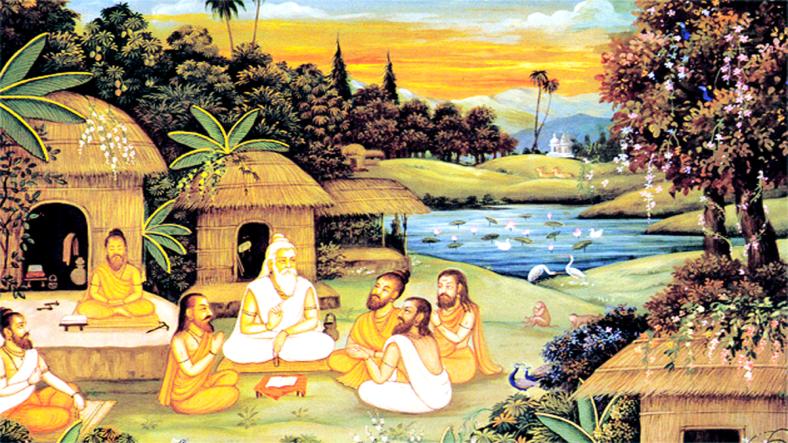Mantras and chants hold a central place in Vedic rituals, embodying the profound spiritual and symbolic dimensions of ancient Hindu practices. These sacred utterances, derived from the Vedic texts, are more than mere sounds; they are considered powerful tools for invoking divine energies, maintaining cosmic order and achieving spiritual goals.
This article explores the significance of mantras and chants in Vedic rituals, examining their origins, functions and impact on ritual practice.
Google Ad 1
Origins and Significance of Mantras
- Definition and Etymology
- Mantra:
- The term mantra comes from the Sanskrit roots manas (mind) and tra (instrument or tool), meaning "a tool for the mind" or "instrument of thought."
- Mantras are sacred sounds or phrases believed to possess inherent spiritual power.
- Chants: Chants refer to the rhythmic recitation or singing of mantras. The act of chanting is integral to Vedic rituals, enhancing the efficacy of the mantras through repetition and vocalization.
- Mantra:
- Historical Roots
- Vedic Texts:
- The earliest references to mantras are found in the Vedas, particularly in the Rigveda and Yajurveda.
- These texts contain a vast array of hymns, prayers and chants used in various rituals.
- Transmission: Mantras were traditionally transmitted orally from teacher to student, preserving their exact pronunciation, intonation and ritualistic significance.
- Vedic Texts:
Functions of Mantras and Chants in Vedic Rituals
- Invocation and Invocation of Divine Powers
- Deity Invocation:
- Mantras are used to invoke the presence and blessings of deities during rituals.
- By reciting specific mantras, practitioners seek to establish a connection with divine beings and invite their participation in the ritual.
- Cosmic Alignment:
- Mantras are believed to align the ritual with cosmic forces and maintain the harmony of the universe.
- They help bridge the gap between the human and divine realms, ensuring that offerings and prayers reach their intended recipients.
- Deity Invocation:
- Purification and Protection
- Spiritual Purification:
- Mantras are chanted to purify the ritual space, participants and offerings.
- The sound vibrations are thought to cleanse negative energies and create a sacred environment conducive to the ritual.
- Protection:
- Certain mantras are recited to invoke protective energies and safeguard the ritual from any potential disruptions or negative influences.
- They are believed to create a shield of divine protection around the participants.
- Spiritual Purification:
- Focus and Concentration
- Mental Discipline:
- Chanting mantras helps focus the mind and enhance concentration during rituals.
- The repetitive nature of chanting aids in mental discipline, allowing practitioners to remain attentive and engaged in the ritual process.
- Spiritual Immersion:
- Mantras facilitate a deep meditative state, enabling practitioners to immerse themselves in the spiritual aspects of the ritual.
- This immersion enhances the overall efficacy and transformative power of the ritual.
- Mental Discipline:
Types of Mantras
- Vedic Mantras
- Sanskrit Verses:
- Vedic mantras are composed in Sanskrit and often take the form of verses or hymns.
- They are categorized based on their use in various rituals and their specific attributes.
- Examples: Prominent Vedic mantras include the Gayatri Mantra, which praises the divine light of the sun and the Asato Ma Sadgamaya, which seeks guidance from darkness to light.
- Sanskrit Verses:
- Tantric Mantras
- Esoteric Practices:
- Tantric mantras are used in esoteric practices and rituals, focusing on the transformation of energy and consciousness.
- They often involve complex phonetic structures and specific deity names.
- Examples: Mantras associated with tantric deities, such as Kali or Durga, are recited to invoke their divine presence and blessings in specialized rituals.
- Esoteric Practices:
- Upanishadic Mantras
- Philosophical Insights:
- Upanishadic mantras delve into philosophical and metaphysical concepts, exploring the nature of reality, the self and the ultimate truth.
- They are used in meditative practices and philosophical discourses.
- Examples: Mantras from the Upanishads, such as the Om (the primordial sound), represent the essence of the divine and the fundamental reality of existence.
- Philosophical Insights:
Role of Mantras in Ritual Practice
- Ritual Preparation
- Preparation and Purification:
- Mantras are recited during the preparation phase of rituals to sanctify the space, the ritual tools and the participants.
- This preparatory chanting sets the stage for the main ritual activities.
- Invocation of Energies: Mantras are used to invoke the energies required for the ritual, ensuring that the environment is charged with divine presence and auspiciousness.
- Preparation and Purification:
- During the Ritual
- Offering and Sacrifice:
- Mantras are recited while making offerings into the ritual fire or presenting them to deities.
- The chanting of mantras enhances the potency of the offerings and ensures their acceptance by the divine.
- Hymns and Prayers:
- Mantras are chanted as hymns and prayers, expressing devotion, gratitude and requests for blessings.
- They form the core of the ritualistic communication between humans and the divine.
- Offering and Sacrifice:
- Conclusion of the Ritual
- At the end of the ritual, mantras are chanted to conclude the ceremony and express thanks to the deities.
- This final chanting seals the ritual, ensuring that its effects are realized and that the participants are blessed.
Contemporary Practices and Adaptations
- Modern Hindu Rituals
- Adaptations:
- In contemporary Hinduism, mantras continue to play a central role in both traditional and modern rituals.
- While the essence of the mantras remains unchanged, their applications have adapted to modern contexts and practices.
- Integration with Yoga and Meditation:
- Mantras are widely used in modern yoga and meditation practices to enhance spiritual experiences and mental focus.
- They are chanted to deepen meditation, achieve inner peace and connect with higher states of consciousness.
- Adaptations:
- Global Influence
- Popularization:
- The global popularity of mantras and chants has expanded beyond traditional rituals to include spiritual and wellness practices worldwide.
- Mantras are often incorporated into mindfulness, stress relief and holistic health practices.
- Cultural Exchange: The spread of mantras and their integration into various cultural and spiritual traditions highlight their universal appeal and effectiveness in promoting spiritual well-being.
- Popularization:
Conclusion
Mantras and chants are integral to Vedic rituals, embodying the spiritual and symbolic dimensions of these ancient practices. Their role in invocation, purification, focus and protection underscores their profound impact on ritual efficacy and spiritual experience. From their origins in the Vedic texts to their contemporary applications, mantras continue to be powerful tools for connecting with the divine, maintaining cosmic harmony and enhancing spiritual growth. Their enduring significance in both traditional and modern contexts attests to the timeless relevance of these sacred utterances in the pursuit of spiritual enlightenment and well-being.














